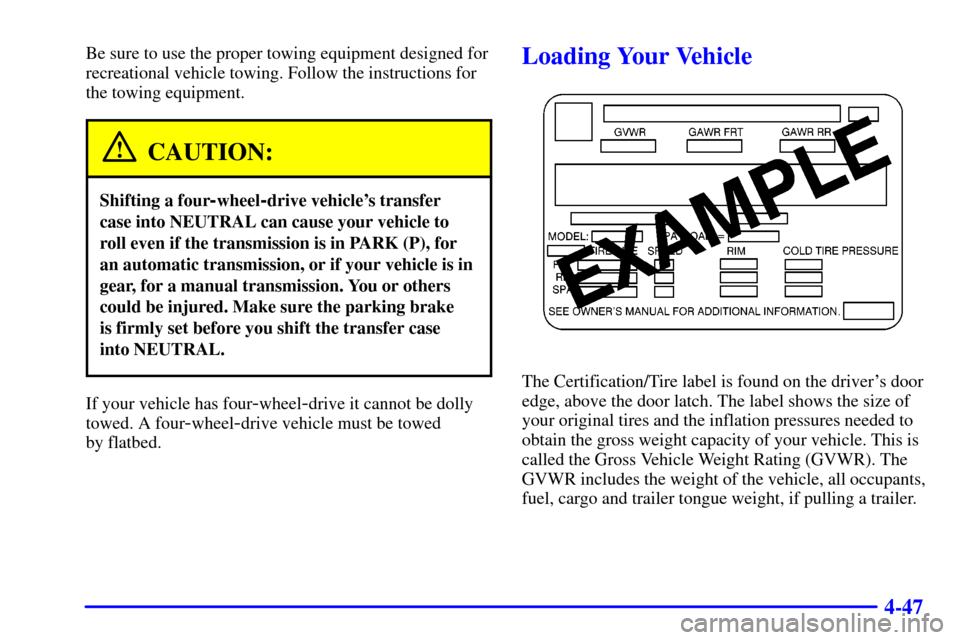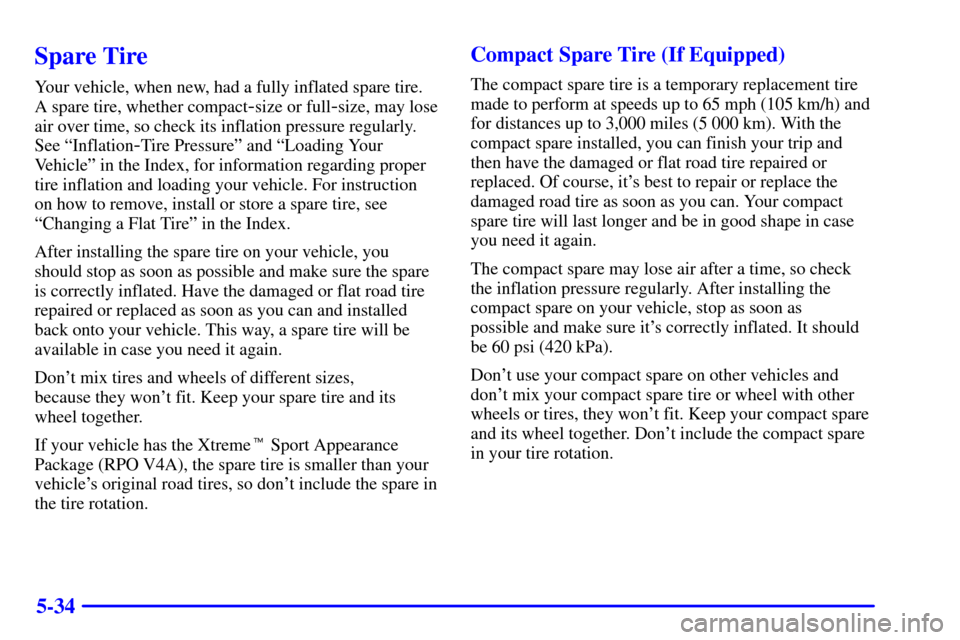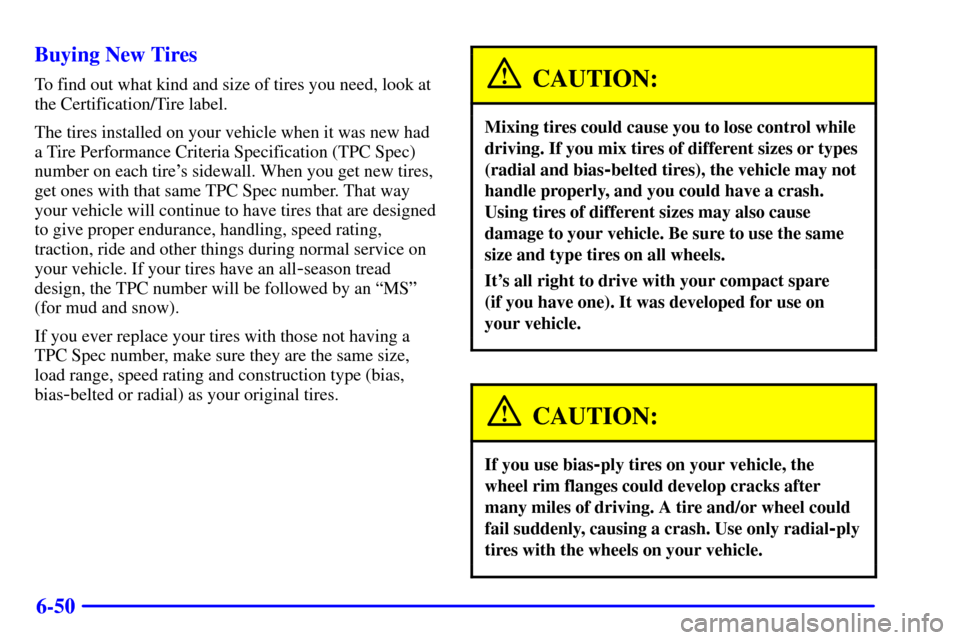Page 292 of 488

4-47
Be sure to use the proper towing equipment designed for
recreational vehicle towing. Follow the instructions for
the towing equipment.
CAUTION:
Shifting a four-wheel-drive vehicle's transfer
case into NEUTRAL can cause your vehicle to
roll even if the transmission is in PARK (P), for
an automatic transmission, or if your vehicle is in
gear, for a manual transmission. You or others
could be injured. Make sure the parking brake
is firmly set before you shift the transfer case
into NEUTRAL.
If your vehicle has four-wheel-drive it cannot be dolly
towed. A four
-wheel-drive vehicle must be towed
by flatbed.
Loading Your Vehicle
The Certification/Tire label is found on the driver's door
edge, above the door latch. The label shows the size of
your original tires and the inflation pressures needed to
obtain the gross weight capacity of your vehicle. This is
called the Gross Vehicle Weight Rating (GVWR). The
GVWR includes the weight of the vehicle, all occupants,
fuel, cargo and trailer tongue weight, if pulling a trailer.
Page 342 of 488

5-34
Spare Tire
Your vehicle, when new, had a fully inflated spare tire.
A spare tire, whether compact
-size or full-size, may lose
air over time, so check its inflation pressure regularly.
See ªInflation
-Tire Pressureº and ªLoading Your
Vehicleº in the Index, for information regarding proper
tire inflation and loading your vehicle. For instruction
on how to remove, install or store a spare tire, see
ªChanging a Flat Tireº in the Index.
After installing the spare tire on your vehicle, you
should stop as soon as possible and make sure the spare
is correctly inflated. Have the damaged or flat road tire
repaired or replaced as soon as you can and installed
back onto your vehicle. This way, a spare tire will be
available in case you need it again.
Don't mix tires and wheels of different sizes,
because they won't fit. Keep your spare tire and its
wheel together.
If your vehicle has the Xtreme� Sport Appearance
Package (RPO V4A), the spare tire is smaller than your
vehicle's original road tires, so don't include the spare in
the tire rotation.
Compact Spare Tire (If Equipped)
The compact spare tire is a temporary replacement tire
made to perform at speeds up to 65 mph (105 km/h) and
for distances up to 3,000 miles (5 000 km). With the
compact spare installed, you can finish your trip and
then have the damaged or flat road tire repaired or
replaced. Of course, it's best to repair or replace the
damaged road tire as soon as you can. Your compact
spare tire will last longer and be in good shape in case
you need it again.
The compact spare may lose air after a time, so check
the inflation pressure regularly. After installing the
compact spare on your vehicle, stop as soon as
possible and make sure it's correctly inflated. It should
be 60 psi (420 kPa).
Don't use your compact spare on other vehicles and
don't mix your compact spare tire or wheel with other
wheels or tires, they won't fit. Keep your compact spare
and its wheel together. Don't include the compact spare
in your tire rotation.
Page 393 of 488
6-48
When rotating your tires, always use one of the correct
rotation patterns shown here.If your vehicle has a compact spare tire or a spare tire
that does not match your vehicle's regular road tires and
wheels in size and type, do not include the spare in the
tire rotation.
After the tires have been rotated, adjust the front and
rear inflation pressures as shown on the
Certification/Tire label. Make certain that all wheel nuts
are properly tightened. See ªWheel Nut Torqueº in
the Index.
CAUTION:
Rust or dirt on a wheel, or on the parts to which
it is fastened, can make wheel nuts become loose
after a time. The wheel could come off and cause
an accident. When you change a wheel, remove
any rust or dirt from places where the wheel
attaches to the vehicle. In an emergency, you can
use a cloth or a paper towel to do this; but be
sure to use a scraper or wire brush later, if you
need to, to get all the rust or dirt off. See in
the Index.
Page 395 of 488

6-50 Buying New Tires
To find out what kind and size of tires you need, look at
the Certification/Tire label.
The tires installed on your vehicle when it was new had
a Tire Performance Criteria Specification (TPC Spec)
number on each tire's sidewall. When you get new tires,
get ones with that same TPC Spec number. That way
your vehicle will continue to have tires that are designed
to give proper endurance, handling, speed rating,
traction, ride and other things during normal service on
your vehicle. If your tires have an all
-season tread
design, the TPC number will be followed by an ªMSº
(for mud and snow).
If you ever replace your tires with those not having a
TPC Spec number, make sure they are the same size,
load range, speed rating and construction type (bias,
bias
-belted or radial) as your original tires.
CAUTION:
Mixing tires could cause you to lose control while
driving. If you mix tires of different sizes or types
(radial and bias
-belted tires), the vehicle may not
handle properly, and you could have a crash.
Using tires of different sizes may also cause
damage to your vehicle. Be sure to use the same
size and type tires on all wheels.
It's all right to drive with your compact spare
(if you have one). It was developed for use on
your vehicle.
CAUTION:
If you use bias-ply tires on your vehicle, the
wheel rim flanges could develop cracks after
many miles of driving. A tire and/or wheel could
fail suddenly, causing a crash. Use only radial
-ply
tires with the wheels on your vehicle.
Page 399 of 488
6-54
Used Replacement Wheels
CAUTION:
Putting a used wheel on your vehicle is
dangerous. You can't know how it's been used or
how far it's been driven. It could fail suddenly
and cause a crash. If you have to replace a wheel,
use a new GM original equipment wheel.
Tire Chains
CAUTION:
Don't use tire chains. There's not enough
clearance. Tire chains used on a vehicle without
the proper amount of clearance can cause
damage to the brakes, suspension or other vehicle
parts. The area damaged by the tire chains could
cause you to lose control of your vehicle and you
or others may be injured in a crash.
Use another type of traction device only if its
manufacturer recommends it for use on your
vehicle and tire size combination and road
conditions. Follow that manufacturer's
instructions. To help avoid damage to your
vehicle, drive slowly, readjust or remove the
device if it's contacting your vehicle, and don't
spin your wheels.